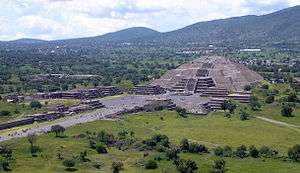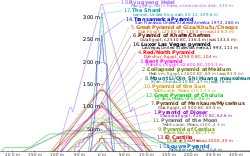Pyramid of the Moon

The Pyramid of the Moon is the second largest pyramid in modern-day San Juan Teotihuacán, Mexico, after the Pyramid of the Sun. It is located in the western part of the ancient city of Teotihuacan and mimics the contours of the mountain Cerro Gordo, just north of the site. Some have called it Tenan, which in Nahuatl, means "mother or protective stone." The Pyramid of the Moon covers a structure older than the Pyramid of the Sun. The structure existed prior to 200 AD.
The Pyramid's construction between 200 and 250 AD completed the bilateral symmetry of the temple complex. A slope in front of the staircase gives access to the Avenue of the Dead, a platform atop the pyramid was used to conduct ceremonies in honor of the Great Goddess of Teotihuacan, the goddess of water, fertility, the earth, and even creation itself. This platform and the sculpture found at the pyramid's bottom are thus dedicated to The Great Goddess.
Opposite the Great Goddess's altar is the Plaza of the Moon. The Plaza contains a central altar and an original construction with internal divisions, consisting of four rectangular and diagonal bodies that formed what is known as the "Teotihuacan Cross."

History
Between 150 BC and 500 AD, a Mesoamerican culture built a flourishing metropolis on a plateau about 22 km2 (8.5 sq mi). The ethnicity of the inhabitants of Teotihuacan is a subject of debate. During the initial phase of Teotihuacan, called Tzacualli (0–150 AD), ingenious building systems were developed to erect the monumental bases of the Pyramids of the moon and the Sun. The Teotihuacan metropolis has a planified urbanization with main axis, and a huge palace surrounded by 15 monumental pyramids. It was said by the Aztecs to have been surmounted by a huge stone figure related to the moon. This figure was uncovered (weighing 22 metric tonnes and was somehow lifted to the top of the pyramid) and it represents the Great Goddess as a water deity.[1] Scholars have suggested that the water that flows through her hands is living water and represents a life-giving force and fertility.
Beginning in 1998, archaeologists excavated beneath the Pyramid of the Moon. Tunnels dug into the structure have revealed that the pyramid underwent at least six renovations; each new addition was larger and covered the previous structure.
As the archaeologists burrowed through the layers of the pyramid, they discovered artifacts that provide the beginning of a timeline to the history of Teotihuacan. In 1999, a team led by Saburo Sugiyama, associate professor at Aichi Prefectural University in Japan and adjunct faculty at Arizona State University,[2] and Ruben Cabrera of Mexico’s National Institute of Anthropology and History, found a tomb apparently made to dedicate the fifth phase of construction. It contains four human skeletons, animal bones, jewelry, obsidian blades, and a wide variety of other offerings. Archeologists estimated that the burial occurred between 100 and 200 AD.
Another tomb dedicated to The Great Goddess was discovered in 1998. It is dated to the fourth stage of construction. It contained a single human male sacrificial victim as well as a wolf, jaguar, puma, serpent, bird skeletons, and more than 400 other relics which include a large greenstone and obsidian figurines, ceremonial knives, and spear points.
See also
- List of megalithic sites
- List of Mesoamerican pyramids
- Great Goddess of Teotihuacan
- Pyramid of the Sun
Notes
- ↑ Walker, Charles, 1980 Wonders of the Ancient World, p. 150-3
- ↑ "Discoveries At Teotihuacan's Pyramid Of The Moon Help Unlock Mysteries Of Western Hemisphere's First Major Metropolis". ScienceDaily. Arizona State University, College Of Liberal Arts & Sciences. September 21, 1999.
External links
| Wikimedia Commons has media related to Pirámide de la Luna. |
Coordinates: 19°41′59″N 98°50′38″W / 19.6996°N 98.8440°W